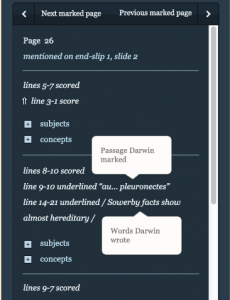Charles Darwin’s Library is a new digital database of the books Darwin was reading as he began to create the theory of evolution, and the annotations he was making.

At first, Charles Darwin’s scribbles in the margins evolved into a theory that would turn the world upside down.

Now, those first musings of evolution have evolved into a whole new state of being: a digital archive.
But how did this evolution occur?
What is this library and where did it come from?
All of the documents used in this project were a part of Darwin’s original reading inventory. Much of it was given to museums after Darwin’s death, while others have ended up in private or public collections.
So far, this digital library includes scans or digital representations of:
- 330 books, complete annotations and margin mark-ups
- 28,951 marked pages and 1,624 inserted note cards
- 120 high-resolution scans of books
- Original abstracts authored by Darwin
- Darwin’s reading notebooks and reading lists
- Other documents pertaining to Darwin’s life that give some clue as to what he was reading such as sales slips of bookstores and borrowing lists of libraries
What can you do with the digital library?
The Biodiversity Heritage Libarary, which hosted the creation of this digital library, also provided several tools that can be used to analyze and explore Darwin’s library.
- Notes relating to certain pages in books are automatically paired with the pages they pertain to
- Ability to search annotations and documents by author, title, or year
How is the library presented?
The library database is presented using an original transcription interface created by the Biodiversity Heritage Library. This interface can be accessed by using the BHL website and allows users to see the scanned copies of Darwin’s documents, books, and annotations. The website utilizes lots of lists that are browsable and clickable to redirect to the actual documents. Line numbers have been added to the documents to make references and navigation easier, and the toolbar to the side (see above) allows users to easily navigate Darwin’s annotations and related notes.
Charles Darwin’s Library is a well-constructed resource that will doubtless facilitate many other humanities and digital humanities projects in the future, while allowing those with a more casual interest deep insight into Darwin’s mind.

Darwin’s Library looks like a fascinating project, and your post is a really great profile of it– the formatting is creative and the information is presented in a helpful way, making engaging and easy to read.
Darwin’s library is one of the most important collection. The digital project, although it wasn’t that pleasing to the eye in terms of pretty-ness, it is very detailed and easy to navigate. Your analyses of the process is elaborate and to the point. Thank you!
The overall spacing and color usage of you post looks reallyprofessional. I suggest that you can use this link to the img instead.